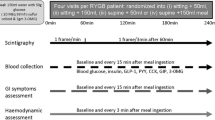Summary
The effects of hyperglycaemia on postprandial small intestinal motor activity are unclear. Duodenal and jejunal pressures and duodeno-caecal transit were measured in eight healthy male volunteers during euglycaemia (blood glucose 4–6 mmol/l) and hyperglycaemia (blood glucose 12–15 mmol/l). Duodenal and jejunal pressures were recorded with a manometric assembly during intraduodenal infusion of 100 ml nutrient liquid comprising 14% protein, 31.5% fat and 54.5% carbohydrate together with 15 g lactulose. Duodeno-caecal transit was determined by a breath hydrogen technique. The number of duodenal (p<0.05) and jejunal (p<0.01) pressure waves, excluding phase III episodes was reduced during hyperglycaemia compared to euglycaemia. Hyperglycaemia was associated with earlier onset of phase III activity (30±12 vs 132±20 min; p<0.05). Duodeno-caecal transit was slower during hyperglycaemia when compared to euglycaemia (114±17 vs 49±6 min, p<0.01). We conclude that induced hyperglycaemia has major effects on postprandial small intestinal motility. The reduction in duodenal and jejunal motor activity is likely to explain the retardation of small intestinal transit during hyperglycaemia.
Similar content being viewed by others
Abbreviations
- TMPD:
-
Transmusocal potential difference
- MMC:
-
migrating myoelectric complex
References
Feldman M, Schiller LR (1983) Disorders of gastrointestinal motility associated with diabetes mellitus. Ann Int Med 98: 378–384
Horowitz M, Dent J (1991) Disordered gastric emptying: mechanical basis, assessment and treatment. Baillieres's Clinical Gastroenterology 5: 371–407
Scarpello JHB, Greaves M, Sladen GE (1976) Small intestinal transit in diabetics. BMJ:1225–1226
Keshavarzian A, Iber FL (1986) Intestinal transit in insulin-requiring diabetics. Am J Gastroenterol 81: 257–260
De Boer SY, Masclee AAM, Lam WF, Lamers CBHW (1992) Effect of acute hyperglycaemia on esophageal motility and lower esophageal sphincter pressure in humans. Gastroenterology 103: 775–780
Barnett JL, Owyang C (1988) Serum glucose concentration as a modulator of interdigestive gastric motility. Gastroenterology 94: 739–744
Fraser R, Horowitz M, Dent J (1991) Hyperglycaemia stimulates pyloric motility in normal subjects. Gut 31: 475–478
Hasler WL, Soudah HC, Dulai G, Owyang C (1995) Mediation of hyperglycemia-evoked gastric slow-wave dysrhythmias by endogenous prostaglandins. Gastroenterology 108: 727–736
De Boer SY, Masclee AAM, Lam WF, Schipper J, Jansen JBMJ, Lamers CBHW (1993) Hyperglycaemia modulates gallbladder motility and small intestinal transit time in man. Dig Dis Sci 38: 2228–2235
Sims MA, Hasler WL, Chey WD, Kim MS, Owyang C (1995) Hyperglycemia inhibits mechanoreceptor-mediated gastrocolonic reponses and colonic peristaltic reflexes in healthy humans. Gastroenterology 108: 350–359
Fraser R, Horowitz M, Maddox AF, Harding PE, Chatterton BE, Dent J (1990) Hyperglycaemia slows gastric emptying in type 1 (insulin-dependent) diabetes mellitus. Diabetologia 33: 675–680
Bjornsson ES, Urbanavicius V, Eliasson B, Attvall S, Smith U, Abrahamsson H (1994) Effects of hyperglycaemia on interdigestive gastrointestinal motility in humans. Scand J Gastroenterol 29: 1096–1104
Kim CH, Kennedy FP, Stadheim LM, Nelson DK (1990) Hyperglycaemia does not influence postprandial gastrointestinal (GI) motility but suppresses postprandial release of pancreatic polypeptide (PP), neurotensin (NT), and peptide YY (PYY). Gastroenterology 98:A366 (Abstract)
Fraser R, Shearer T, Fuller J, Horowitz M, Dent J (1992) Intravenous erythromycin overcomes small intestinal feedback on antral, pyloric and duodenal motility. Gastroenterology 103: 114–119
Heddle R, Dent J, Read NW et al. (1988) Antropyloro-duodenal motor responses to intraduodenal lipid infusion in healthy volunteers. Am J Physiol (Gastrointest Liver Physiol 17) 254:G671-G679
Fone D, Horowitz M, Dent J, Read NW, Heddle R (1989) Pyloric motor response to intraduodenal dextrose involves muscarinic mechanisms. Gastroenterology 97: 83–90
Read NW (1991) Measurement of small bowel transit in humans. In: Kamm MA, Lennard-Jones JE (eds) Gastrointestinal transit Wrighton Biomedical Publishing Petersfield, pp 97–108
Sarna SK (1985) Cyclic motor activity; migrating motor complex. Gastroenterology 89: 894–913
Oberle RL, Chen TS, Loyd C, Barnett JL, Owyang C, Meyer J, Amidon GL (1990) The influence of the interdigestive migrating myoelectric complex on the gastric emptying of liquids. Gastroenterology 99: 1275–1282
Summers RW, Helm J, Christensen J (1976) Intestinal propulsion in the dog. Gastroenterology 70: 753–758
Prasad KR, Sarna SK (1986) The central and peripheral effects of insulin on migrating myoelectric complexes (MMC). Gastroenterology 92: 1589 (Abstract)
Fellows IW, Evans DP, Bennett T, MacDonald IA, Clark AG, Bloom SR (1987) The effect of insulin-induced hypoglycaemia on gastrointestinal motility in man. Clin Sci 72: 743–748
Hebbard GS, Sun W, Dent J, Horowitz M (1994) Acute hyperglycaemia increases proximal gastric compliance. Gastroenterology 106:A509 (Abstract)
Chey WD, Kim M, Hasler WL, Owyang C (1995) Hyperglycaemia alters perception of rectal distension and blunts the rectoanal inhibitory reflex in healthy volunteers. Gastroenterology 108: 1700–1708
Horowitz M, Fraser R (1994) Disordered gastric motor function in diabetes mellitus. Diabetologia 37: 543–551
Camilleri M, Malagelada JR (1984) Abnormal intestinal motility in diabetics with the gastroparesis syndrome. Eur J Clin Invest 14: 420–427
Author information
Authors and Affiliations
Rights and permissions
About this article
Cite this article
Russo, A., Fraser, R. & Horowitz, M. The effect of acute hyperglycaemia on small intestinal motility in normal subjects. Diabetologia 39, 984–989 (1996). https://doi.org/10.1007/BF00403919
Received:
Revised:
Issue Date:
DOI: https://doi.org/10.1007/BF00403919




